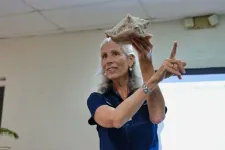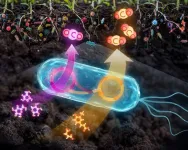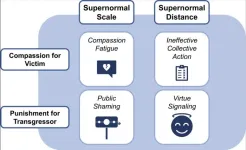(Press-News.org) The queen conch (Aliger gigas) is a prized delicacy long harvested for food and revered for its beautiful shell. With a lifespan between 25 to 40 years, the queen conch is second only to the spiny lobster fishery and is the most important molluscan fishery in the Caribbean region.
Deeply rooted in the way of life in the Caribbean, many island communities depend on queen conch for their livelihoods. However, intensive fishing and habitat degradation from urbanization and climate change have caused conch populations to significantly dwindle.
Megan Davis, Ph.D., a research professor at Florida Atlantic University’s Harbor Branch Oceanographic Institute, has spent more than 40 years conserving and restoring the queen conch. Now, she and Becky Holt, an assistant director for their aquaculture and conservation program at FAU Harbor Branch, share their vast expertise and knowledge in growing and sustaining the queen conch.
Davis and Holt recently launched “eConch,” a free online training program to grow queen conch, which was developed in collaboration with FAU’s Center for Online and Continuing Education. The program is easy to follow, allows users to move at their own pace, includes high-quality video and provides access to expert advice. The training also includes a comprehensive manual, which provides step-by-step complete illustrations and photos of how to culture queen conch.
The manual includes the science and art of growing queen conch, which Davis developed over four decades, designing, implementing and operating experimental size aquaculture facilities as well as production-scale facilities in Florida and throughout the Caribbean.
“We have received numerous requests throughout Florida and the Caribbean from community members, researchers, aquaculturists, conservationists, educators and students to learn how to conserve and culture queen conch,” said Davis, who is internationally renowned for her research and work with queen conch. “We are incredibly excited to be able to respond to these inquiries with eConch, a first-of-its-kind, free online training program.”
eConch is an experiential online learning program that includes seven descriptive how-to modules. Module topics include collection and hatching of egg masses; larval rearing in the hatchery; microalgae culture to feed the larvae; metamorphosis; nursery culture of the juveniles; ranching for food; and restoration of the species.
“In addition to their socioeconomic importance, the queen conch plays a critical ecological role in seagrass beds,” said Davis. “Aquaculture, along with conservation of breeding populations and fishery management, are ways we can help ensure longevity of this important species.”
In 2019, Davis teamed up with Conservación ConCiencia and Naguabo Fishing Association in Puerto Rico to assist with stock enhancement of the queen conch. The Naguabo Aquaculture Center, which has a queen conch hatchery and nursery for restoration, serves as a demonstration and training facility for Puerto Rico and other Caribbean countries.
“Our work in Puerto Rico has been instrumental in developing and launching eConch and providing an innovative way to save the queen conch,” said Davis. “eConch uses videos and visuals from the Naguabo Aquaculture Center to provide an immersive and hands-on learning experience.”
The goal of this collaboration in Puerto Rico is to produce up to 2,000 queen conch juveniles in a fishers-operated aquaculture facility for release into conch juvenile habitats. The Saltonstall-Kennedy NOAA Fisheries and USDA Agricultural Research Service funded project includes aiding sustainable fisheries practices through aquaculture. The team is working with the fishery communities, utilizing the commercial Fishing Association’s working waterfront for conch aquaculture infrastructure, helping provide diversified incomes for the fishery and local communities, promoting aquaculture practices and ensuring the conch population is available for future fishing and food security through aquaculture and restoration.
For more information about eConch, visit www.conchaquaculture.org.
- FAU -
About Harbor Branch Oceanographic Institute:
Founded in 1971, Harbor Branch Oceanographic Institute at Florida Atlantic University is a research community of marine scientists, engineers, educators, and other professionals focused on Ocean Science for a Better World. The institute drives innovation in ocean engineering, at-sea operations, drug discovery and biotechnology from the oceans, coastal ecology and conservation, marine mammal research and conservation, aquaculture, ocean observing systems and marine education. For more information, visit www.fau.edu/hboi.
About Florida Atlantic University:
Florida Atlantic University, established in 1961, officially opened its doors in 1964 as the fifth public university in Florida. Today, the University serves more than 30,000 undergraduate and graduate students across six campuses located along the southeast Florida coast. In recent years, the University has doubled its research expenditures and outpaced its peers in student achievement rates. Through the coexistence of access and excellence, FAU embodies an innovative model where traditional achievement gaps vanish. FAU is designated a Hispanic-serving institution, ranked as a top public university by U.S. News & World Report and a High Research Activity institution by the Carnegie Foundation for the Advancement of Teaching. For more information, visit www.fau.edu.
END
The toxic gas ethylene oxide, at levels thousand times higher than what is considered safe, was detected across parts of Louisiana with a cutting-edge mobile air-testing lab. The concentrations found dwarfed Environmental Protection Agency estimates for the region.
The findings, led by Johns Hopkins University environmental engineers, suggest significantly higher cancer risks for people who live near facilities that manufacture and use ethylene oxide, as well as a need for more accurate and reliable tools to monitor emissions.
“I don’t think there’s any census track in the area that wasn’t at higher risk for cancer than we would deem acceptable,” said ...
When soil microbes eat plant matter, the digested food follows one of two pathways. Either the microbe uses the food to build its own body, or it respires its meal as carbon dioxide (CO2) into the atmosphere.
Now, a Northwestern University-led research team has, for the first time, tracked the pathways of a mixture of plant waste as it moves through bacteria’s metabolism to contribute to atmospheric CO2. The researchers discovered that microbes respire three times as much CO2 from lignin carbons (non-sugar aromatic units) compared to cellulose carbons (glucose sugar units), which both add structure and support ...
In a Review article, Claire Robertson and colleagues explore how human morality, which evolved in the context of small in-person groups, functions on the internet with over five billion users. Evolved human responses, such as compassion for victims and urges to punish transgressors, operate differently online, the authors argue. The internet exposes users to large quantities of extreme morally relevant stimuli in the form of 24-hour news and intentionally outrageous content from sometimes physically distant locations. Subjecting human brains to this ...
Consumer data shows people with obesity are more price-sensitive than others when it comes to buying unhealthy foods, suggesting a food tax could be an effective public health measure. Taxes on sugar-sweetened beverages have become a commonly employed policy to improve public health. Less common are taxes on unhealthy foods, such as candy, cookies, or potato chips--and there is little data on whether such taxes would improve public health. Ying Bao and colleagues examined whether individuals of various ...
In the 2021–2022 school year, schools banned books more often than ever before in United States history. Katie Spoon, Isabelle Langrock, and colleagues analyzed data from PEN America on 2,532 book bans that occurred during the year, in combination with county-level administrative data, book sales data, and a novel crowd-sourced dataset of author demographic information. The research team found that people of color are several times more likely to be the authors of banned books than White authors and that a considerable proportion of banned books, both fictional and historical, feature characters of color. About 37% of banned books were children’s ...
Patients with pre-diabetes and severe obesity who had metabolic and bariatric surgery were 20-times less likely to develop full-blown type 2 diabetes over the course of 15 years than patients with the condition who did not have surgery, according to a new study* presented today at the American Society for Metabolic and Bariatric Surgery (ASMBS) 2024 Annual Scientific Meeting.
Only 1.8% of patients progressed to a diagnosis of diabetes in five years after metabolic surgery (Roux-en-Y gastric bypass or sleeve gastrectomy), which rose to 3.3% in 10 years and 6.7% after 15 years. The protective effect against diabetes was higher ...
SAN DIEGO – June 11, 2024 – Two new studies* presented today at the American Society for Metabolic and Bariatric Surgery (ASMBS) 2024 Annual Scientific Meeting suggest total robotic metabolic and bariatric surgery may result in shorter operative times, reduced lengths of stay and lower complications compared to laparoscopic approaches.
In one study, researchers from AdventHealth in Celebration, FL examined the outcomes of a single surgeon who performed 809 metabolic and bariatric operations – 498 totally robotic and 311 laparoscopic -- between 2020 and 2023. They found total robotic Roux-en-Y gastric bypass (RYGB) resulted in significantly shorter ...
SAN DIEGO – June 11, 2024 – Systematic reviews* of medical literature between 2020 to 2024 show bariatric surgery, also known as metabolic or weight-loss surgery, produces the greatest and most sustained weight loss compared to GLP-1 receptor agonists and lifestyle interventions. The study was presented today at the American Society for Metabolic and Bariatric Surgery (ASMBS) 2024 Annual Scientific Meeting.
Researchers found lifestyle interventions such as diet and exercise resulted in an average weight loss of 7.4% but that weight was generally regained within 4.1 years. GLP-1s and metabolic ...
PULLMAN, Wash. – Who proposes a bill matters more to Republican men than what it says—at least when it comes to the environment, a recent study found.
In an experiment with 800 adults, researchers used an article describing a hypothetical U.S. Senate bill about funding state programs to reduce water pollution to test partisan preferences, changing only the political affiliation of the proposal’s sponsors. Democrats in the study who favored the proposal supported the legislation no matter who proposed it and at higher levels than the Republican participants. Republicans’ support varied, however, dropping about 18% when it was described as being ...
A new study has revealed significant progress in the drive to reduce levels in the atmosphere of chemicals that destroy Earth’s ozone layer, confirming the success of historic regulations limiting their production.
The findings, led by the University of Bristol and published today in Nature Climate Change, show for the first time a notable decline in the atmospheric levels of potent ozone-depleting substances (ODS), called hydrochlorofluorocarbons (HCFCs). These HCFCs are also harmful greenhouse gases, so a reduction should also lessen global warming.
The Montreal Protocol was agreed to internationally in 1987 to introduce controls on the production and usage of ODS, which were once ...





